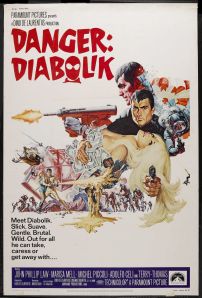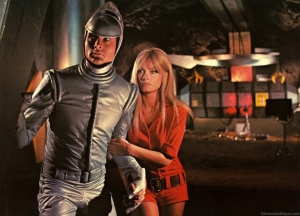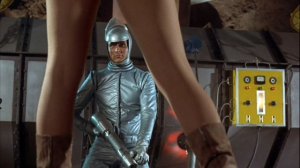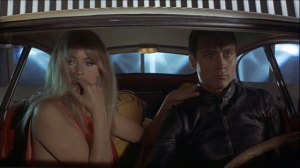 Italy, 1968. Dir: Mario Bava
Italy, 1968. Dir: Mario BavaStarring John Phillip Law, Marisa Mell, Michel Piccoli, Adolfo Celi, Terry-Thomas
The word cool just doesn’t do justice to Danger: Diabolik. It’s an uber-cool cult classic. If Danger: Diabolik is Dino De Laurentiis’ sibling movie to his own Barbarella from the same year, then it’s a trendier and wiser younger brother. After a run of mould-breaking and influential horror films, Mario Bava used his expert craftmanship to perfectly capture many popular traits of late-1960′s cinema: the spy thriller, the heist movie, exploitative sex and violence, and colourful escapism. Far from being euro trash, Danger: Diabolik is sublime pop art. It’s the Citizen Kane of hip psychotronic cinema, a comparison that isn’t quite as daft as it first sounds – Bava’s inventive, experimental and influential techniques have more in common with Orson Welles than one might imagine. For example, Diabolik’s underground lair, largely created through stunning matte paintings and subtle framing, is completely in the spirit of Welles’ audacious design for Kane’s Xanadu. Adapted from the popular Italian fumetti comic featuring the iconic anti-hero Diabolik, Bava succeeds in recreating the visual pace of the comic strip with cinematic flair. Clearly aware that the art of the comic book panel is to capture movement and emotional intensity in a still image, Bava injects every shot with a similar sense of depth and perspective, and every cut with the same dramatic urgency. His famously resourceful use of a small budget is remarkable – the impressive sets rival You Only Live Twice, tremendous underwater sequences are the equal of Thunderball, but all are filmed for a pittance of the Bond budget.
 Contemporary
Contemporary critics assumed that Danger: Diabolik was stylistically informed by the high camp of the Batman TV series (ABC 1966 – 68), but in fact the two have little in common beyond the obvious comic book source and the paranoid city bureaucrats akin to Gotham City. But whilst Batman is unabashedly campy and a clear-cut good vs evil duel, Diabolik goes way beyond camp, acknowledging and relishing its own extravagances to the point of satire (30 years before Austin Powers foolishly thought it was clever to parody what was already a parody) and ploughing a far more subversive, morally skewed path. The character of Diabolik represents the archetype of the European criminal as a heroic figure. Unlike the victorious and moralistic American super-heroes, post-war Italy had a healthy cynicism for government and capitalism, and by the 1960′s Diabolik filled the need for a counterculture anti-hero who goes so far as to destroy all government buildings representing funding and taxation. Also noteworthy, whilst USA superheroes live with their butlers or etch out respectable careers as journalists, Diabolik proves that bad guys have more fun, revelling in his hedonistic lifestyle of casual sex and violence.
Danger: Diabolik fully embraces the late 60′s counter-culture ethos, with its attacks on materialistic pleasures and desire to bring down the state. In a perfect visual rendering of both these ideas, after Diabolik has stolen $10 million in bank notes from the government, he simply uses the money to make love in – and on a revolving love nest too! Diabolik is
 avarice
personified and crucially he doesn’t even have an alter-ego – when
Diabolik removes his mask he is still Diabolik, hungry for the
gratification of sex or wealth and living the life of a decadent hermit.
But there’s a doomed loneliness to the life of Diabolik and Eva Kant
(his icy blonde sexpot companion), living in luxury but still living a
trapped existence separate from any form of society. They’re like Bonnie
and Clyde, only less rounded and charismatic! The criminals here are a
vapid and humourless pair, almost enough to make one root for the police
– if they weren’t so inept. As such, the moral tone of Danger: Diabolik is
a confusing one – neither the good or bad guys illicit any real
compassion, but one thing’s for sure: dislikeable people committing
horrendous acts (even mass terrorism) has never been so much fun!
avarice
personified and crucially he doesn’t even have an alter-ego – when
Diabolik removes his mask he is still Diabolik, hungry for the
gratification of sex or wealth and living the life of a decadent hermit.
But there’s a doomed loneliness to the life of Diabolik and Eva Kant
(his icy blonde sexpot companion), living in luxury but still living a
trapped existence separate from any form of society. They’re like Bonnie
and Clyde, only less rounded and charismatic! The criminals here are a
vapid and humourless pair, almost enough to make one root for the police
– if they weren’t so inept. As such, the moral tone of Danger: Diabolik is
a confusing one – neither the good or bad guys illicit any real
compassion, but one thing’s for sure: dislikeable people committing
horrendous acts (even mass terrorism) has never been so much fun!The late John Phillip Law (fresh from Barbarella) presents the hardest working pair of eyebrows in the business, his somewhat limited acting style finding its perfect arena here with a deliberately over-egged performance as Diabolik. This is, after all, not a film concerned with ‘acting’ but of actors inhabiting cut-and-paste characters with vim and vigour. Michel Piccoli, better know for his collaborations with Luis Buñuel, may have been paying the rent with this one but gives an enjoyable performance as the head of police obsessively hunting down the elusive master criminal. Ennio Morricone’s score is a connoisseurs delight, an absolutely terrific mix of psychedelic pop and his own unique orchestration of wails and jangling guitars as heard in the Leone westerns. The main theme “Deep Deep Down” is the sexy equal of any Bond theme and “Valmont’s GoGo Pad” captures the hippy zeitgeist as well as “Age Of Aquarius” despite its illegible lyrics! One of the great tragedies of cinema is that the soundtrack never received an official release, all master tapes having been destroyed in a studio fire.
 Danger: Diabolik is
also an incredibly kinky film, its euro trash leanings perhaps allowing
it to flirt dangerously where other mainstream spy movies could only
dream – its fetishistic costumes, explicit drug use and sexual abandon
being enough to make even James Bond think “that’s a bit much!” Like all
Italian films of this era, the slightly off dubbing contributes greatly
to films otherworldly aesthetic. There’s a bizarre mix of beautiful
Italian locales, a central US dollar monetary system and the very
British Terry-Thomas as Minister Of Finance – yes, the unspecified world
of Danger: Diabolik could only exist in an internationally co-financed sixties caper movie!
Danger: Diabolik is
also an incredibly kinky film, its euro trash leanings perhaps allowing
it to flirt dangerously where other mainstream spy movies could only
dream – its fetishistic costumes, explicit drug use and sexual abandon
being enough to make even James Bond think “that’s a bit much!” Like all
Italian films of this era, the slightly off dubbing contributes greatly
to films otherworldly aesthetic. There’s a bizarre mix of beautiful
Italian locales, a central US dollar monetary system and the very
British Terry-Thomas as Minister Of Finance – yes, the unspecified world
of Danger: Diabolik could only exist in an internationally co-financed sixties caper movie!Just as Diabolik’s fate is to be trapped in a mould of molten gold, so the film is a 24-carat encapsulation of a wild and exuberant age of cinema. It represents the zenith (and last gasp) of colourful 1960′s escapism, filled with extravagant sixties fashion and design, before the 1970′s brought with it an earthier, more naturalistic style and a darker realism across all film genres. Even in 1968 the film was not a massive hit, the far more serious tone of 2001: A Space Odyssey and Planet Of The Apes heralding a new level of earnest fantasy that must have made Danger:
 Diabolik look
all the more lightweight and frivolous. Only in retrospect can the
film’s significant place in sixties pop culture be fully recognised.
Time has been more than kind to it, revealing new pleasures of euro-cool
kitsch and iconic pulp fiction with each passing year. The film
literally ends with the largest wink to an audience imaginable, followed
by the most deliriously maniacal laughter ever heard in a film. Diabolik gets the last laugh, in every conceivable sense.
Diabolik look
all the more lightweight and frivolous. Only in retrospect can the
film’s significant place in sixties pop culture be fully recognised.
Time has been more than kind to it, revealing new pleasures of euro-cool
kitsch and iconic pulp fiction with each passing year. The film
literally ends with the largest wink to an audience imaginable, followed
by the most deliriously maniacal laughter ever heard in a film. Diabolik gets the last laugh, in every conceivable sense.Smarter, funnier, sexier and more knowing than any of its contemporaries or forerunners (Bond, Batman, Flint, Powers, and all subsequent superhero movies). The greatest comic book film ever made? Deep down, you know it is.
No comments:
Post a Comment